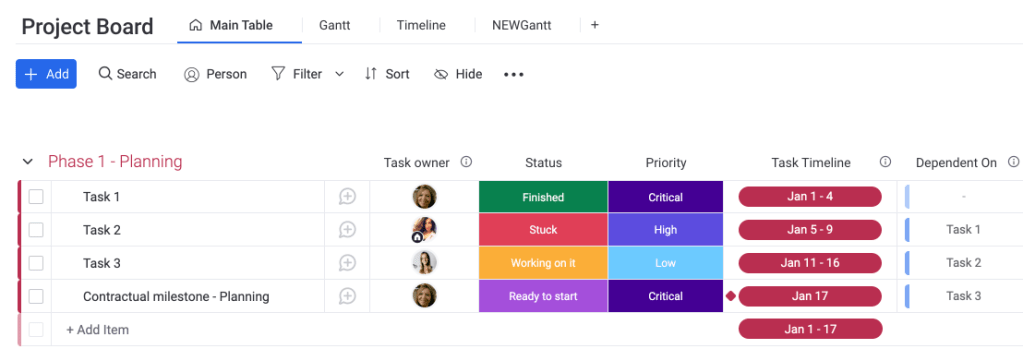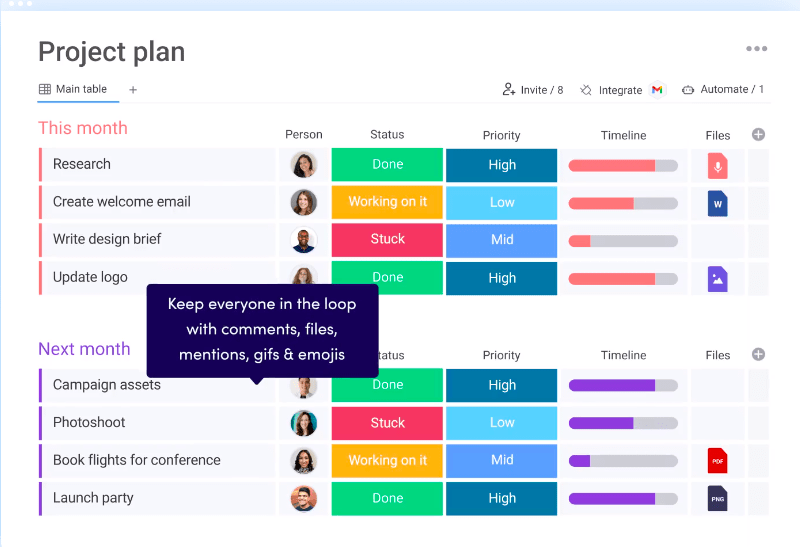Project documentation: an essential guide
Blog: Monday Project Management Blog
Project documentation is a key project management resource that helps set your project up for success. Project documentation can provide clarity and guarantees that everyone involved in a project is on the same page to ensure a project is completed on time and on budget.
In this article, we’ll discuss the importance of project documentation, how you can use it for your project, and tips for choosing the best project documentation software.
What is project documentation?
Project documentation is a collection of data and documents that captures information about a project. Usually, a project manager collects all relevant documents for each stage of a project, including files related to proposals, goals, requirements, design, implementation, budgeting, testing, deployment, and support.
The purpose of project documentation is to gather all documents in one place to make referencing and communication easier.
Project documentation allows project leaders to stay organized, better track progress, and ensure compliance.
The benefits of project documentation
Having all a project’s documents collected helps you work efficiently without wasting time on finding documents or disrupting your team’s workflow when you need to refer back to budgets or when stakeholders ask to see a project proposal or design. Here are some advantages of project documentation:
Improved communication
Documenting your project ensures that it remains transparent and that all stakeholders are on the same page, making it easier to update on different milestones, timelines, and deliverables
Enhanced collaboration
Make collaboration easier by keeping all documents accounted for so that members from different teams all have access to the same information to ensure that everyone is working together towards a common goal.
Increased accountability
When you document different steps of a project, you’re better able to guarantee that different stakeholders are held accountable for the tasks they’re responsible for.
Creates clarity
Project documentation adds value by offering clarity on the progress of work that is done and that remains, as well as setting work requirements, goals, and objectives.
Types of documents included in project documentation
Each project will likely have different documents depending on the scope, type of project, and members involved. That said, any type of project can benefit from using project documentation for the simple reason that it provides organization and clarity. Let’s take a look at a few different types of documents you might include.
- Project charter: A document that outlines a project’s scope, objectives, components, and stakeholders, acting as the general anchor that guides you through milestones
- Statement of work (SOW): A formal agreement between two parties that outlines the scope and objectives of a project, often used when collaborating with external parties
- Project status reports: These reports help project managers track recent updates on tasks to see how a project is progressing
- Risk management plan: An outline of potential risks and roadblocks in a project with plans for how to mitigate or react to them
- Financial plan: A breakdown of a budget and how its meant to be allocated to different tasks and milestones
- Issue tracker: A way for project managers to keep track of issues that arises at any point of the project in order to help prevent larger issues down the road
- Technical document: A document containing the details for using, designing, or developing a technical system along with information on functions and safety
- Rollout plan: A plan that documents how a system will be implemented in an organization including steps, training, and different phases
How to Create Project Documentation
How you create and structure your project documentation is as important as the documents themselves. Take the time to structure it well from the get-go so your team has an easy time browsing, accessing, and sharing the documents they need. Here’s how to do it in 5 steps.
Step 1: Gather all the necessary files
Documents are likely scattered across different platforms, such as emails, hard drives, Word docs, PDFs, internal messages, and more. The first step in preparing the project documentation process is to gather all these tools in one centralized space, such as on a project management solution like monday.com.
Step 2: Ensure documents are descriptive
Each stage of a project will require different documentation. Ensure that you have all the documentation you need for each stage of a project from beginning to end. Of course, it’s normal that more documents will get included as a project progresses, but having the right ones on hand from the beginning will help keep tasks on track.
Step 3: Structure documents for easier search
Existing documents might be full of unnecessary information or comments, which can be distracting when searching for specific data. To save your team time, consider adding features like internal links, a table of contents, or sub-categories to each document.
Step 4: Make it a collaborative effort
It can be difficult to separate pertinent information from noise, so involve your team in the early stages of the project documentation process to help contribute or review and improve important documents. This ensures anything that’s missing, unclear, or out-of-date gets updated.
Step 5: Publish and maintain the documents
When the documents are finalized, make sure to add features such as tags and indexing in the documentation platform so that they’re ready to be searched. Finally, project documentation is an ongoing effort that requires regular maintenance as a project develops. Make sure you regularly review your project documents to ensure they’re relevant and up-to-date.
Best Practices in Writing Project Documentation
Often, files aren’t created with documentation in mind, but it’s important to adapt them accordingly when organizing all your documents to make it easier to retrieve data. Follow these tips for the seamless organization of your project documentation.
Set up a team of contributors
Project documentation should be a collaborative process, so create a team of contributors, editors, and reviewers from different teams to ensure documents are accurate and consistent.
Stick to a structure
Use clear headers, tags, labels, prioritization, topics, and sub-topics to make sure documents are well-structured and anyone can easily search for them.

Use templates
Templates can help you structure project documentation, making it easy to search and reference data. Look for a tool that has built-in documentation templates for a smooth start.
Update regularly
Keep track of version histories but also make sure to update documentation regularly throughout a project’s lifespan to ensure information is always current.
Don’t get bogged down by details
Not every document needs to be highly detailed. For some documents, being concise will make them more accessible. Ensure a document has enough information for tasks that are relevant to it.
Choosing the Right Software for Project Documentation
77% of high-performing projects used software, so turning to an external tool for help documenting your project can help set you up for success. When selecting software, it can be challenging to know which tool has the functionality you need to collaborate effectively. You want to look for something that will fit your project’s scope and your team’s needs. When shopping around, consider the following:
- The software should be simple to use without a major learning curve or specialized training
- Project managers should be able to set access controls
- Look for a tool with built-in project documentation templates to get off the ground quicker
- The software should integrate with your existing tools, such as Slack, Jira, Outlook, or Google Drive
- Make sure both the software and templates are customizable to your needs
A great option for project documentation and other project management workflows is monday.com. With monday.com, you get software that’s entirely customizable to your project’s needs along with project documentation templates to help you get started.
[Image – template GIF from existing page]
Some of the great features monday.com offers for project documentation purposes include:
- Assign a status, owner, department, deadlines, and reviewer to each item
- Integrate all your most-used tools such as Slack, Zoom, Excel, Jira, Asana, and more
- Communicate internally on different documents to always stay up-to-date on tasks
- Collaborate on tasks in real time with all relevant stakeholders
- Get Gantt and Kanban views to oversee the status of your project
- Create automations for approvals and tasks to cut down on manually reviewing items

monday.com offers a solution that’s scalable to your needs, so you can increase or decrease the scope of your documentation efforts based on your project while feeling confident that you’re paying for exactly what you’re using.
FAQs
How do you write a project document?
A project document outlines objectives, goals, scope, timeline, and resources necessary to complete a project. It should be written clearly and concisely so that it’s easily understood by all stakeholders involved.
What are examples of project documentation?
Some different types of project documentation might include a project charter, statement of work, financial plan, risk management plan, issues tracker, and project status report.
How important is documentation in a project?
Documentation allows projects to run more smoothly as it helps stakeholders understand the project scope, timeline, and objectives. Project documentation also helps improve communication, collaboration, and clarity throughout a project’s lifecycle.
monday.com: the solution for structured project documentation
The key to success with project documentation is to remain consistently organized. When your documentation is clean and controlled, the project itself will be off to a good start, and team members will have an easier time completing their tasks with more direct access to the information they need. Tools like monday.com help you keep your documents organized in your own way while also providing complete collaboration and transparency to facilitate a smooth workflow.
The post Project documentation: an essential guide appeared first on monday.com Blog.
Leave a Comment
You must be logged in to post a comment.







